Before you get a new turtle or a tortoise, consider both the acquisition and upkeep costs.
Unlike common pets (such as cats and dogs), turtles require a dedicated enclosure where conditions (such as temperature, humidity, and lighting) emulate that of their natural habitat.
These enclosures also protect them from the outside world. For instance, the turtle’s enclosure protects the turtle from dog attacks. Common household pets can cause serious harm.
Turtle prices vary, with the initial cost of having a pet turtle ranging from $500 to $1500. It is important to be well-prepared before acquiring a turtle.
Table of Contents
Tortoise vs Turtle Costs
As you may imagine, the cost of acquiring the turtle is nothing compared to the upkeep cost. Consider the initial purchase as well as additional costs like setting up an enclosure, feeding, and finally medical costs (such as the cost of veterinarian check-ups). Enclosure needs include the enclosure itself, lighting, heating, a water filter, and many more.
While both tortoises and freshwater turtles are turtles (reptiles of the order Testudines), their needs vary wildly. Tortoises require dry enclosures, while turtles (apart from box turtles) require an aquatic setup.
Tortoises are primarily herbivores and as such about 50-70% of their diet consists of weeds, greens, and other plant matter.
Aquatic turtles, on the other hand, are primarily carnivores and 50-70% of their diet should consist of proteins (such as fish, insects, crustaceans, and worms).
Of course, commercially available tortoise and turtle food can be purchased from most pet stores. You will also need to supplement their diets with vitamins and minerals that can’t be acquired because of their captive lifestyle.
Let us examine both the costs of tortoises and turtles separately.
How Much Does A Tortoise Cost?
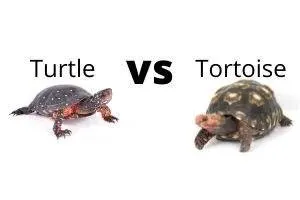
Tortoises, unlike turtles, are terrestrial creatures. They don’t require an aquarium or a pond. However, they generally require more space depending on their size.
Tortoises can and will use as much space as you can use. An outdoor enclosure is better than an indoor enclosure is.
However, unless the climate of your locale is similar to that of the tortoise’s native home, maintaining an outdoor enclosure all year round can be impossible.
The Cost Of Only The Tortoise
The average price of a tortoise can vary, with upfront costs ranging from as low as $50 to as high as $2000. The price of a turtle is influenced by various factors, including species, breed, age, and the seller.
Factors to consider include:
- Age – Adult tortoises tend to be more expensive than hatchlings due to the amount of care invested in the tortoise. Babies are generally $50 to $100. While young turtles may be more affordable, adults usually cost several hundred to several thousand dollars.
- Seller – You can acquire tortoises from reputable breeders, retailers, or even a previous tortoise keeper. Since tortoises grow to over 100 years, they usually have several keepers over their lifetime. Acquiring a tortoise from a private seller has its advantage as these sellers usually include tortoise kits and such.
- Species – Different species have different price tags. Below, I have listed some of the prices you can expect to pay for several popular species.
Breed/Species
Many tortoise species exist, and the type of turtle you choose significantly affects the cost. The ones commonly kept as pets include Sulcata tortoises, Indian star tortoises, leopard tortoises, and Russian tortoises.
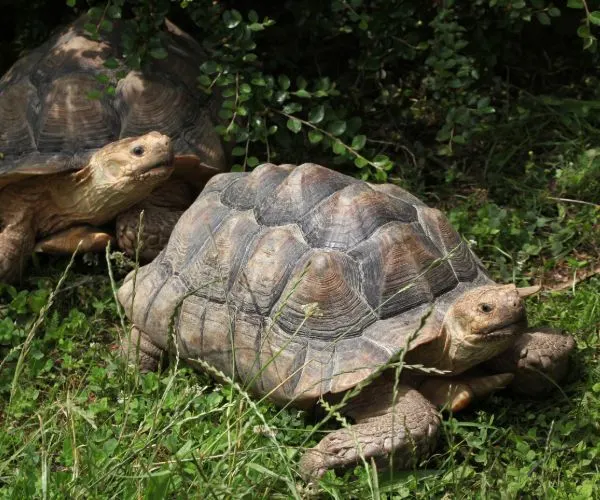
Sulcata tortoise /African spurred tortoise (Centrochelys sulcata) – This is the quintessential pet tortoise. They are probably the most kept tortoises. They are large and grow to an average length of 33 inches (this is almost 3 feet). Due to their large size, they require a tortoise run and not an indoor tortoise table. Expect to pay $50 to $600.

Spur-thighed tortoise/Greek tortoise (Testudo graeca) – This species, also known as Mediterranean spur-thighed tortoises, are popularly kept as pets as they are not very large – with an adult size of just 5 to 8 inches. They can grow to be 125 years old. As such, you can acquire one from a private owner who wishes to pass theirs on. Expect to pay $125 to $150.

Indian star tortoise (Geochelone elegans) – This species grows to 6-15 inches. What makes this turtle popular is its highly ornate shell which is bright yellow with star patterns. These interesting tortoises are shy and are best left to their own devices. Expect to pay $300 to $600.

Hermann’s tortoise (Testudo hermanni) – This is another species popularly kept as pets. The moderately sized Hermann’s tortoise can grow to 5 to 7 inches. These turtles are very easy to keep and are quite gorgeous. Expect to pay $200 to $600.

Red-footed tortoise (Chelonoidis carbonarius) –A red-footed tortoise is a South American turtle that has an average carapace length of 12 inches. Since they are bred on a large scale, they are quite affordable. Expect to pay $100 to $150.
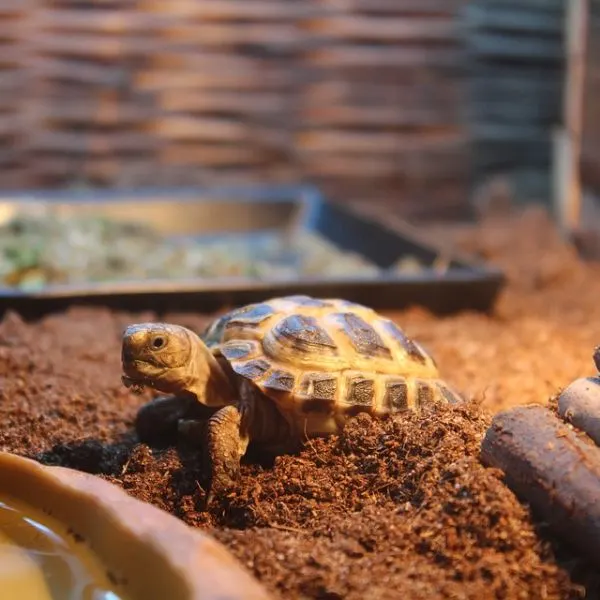
Russian tortoise (Testudo horsfieldii) – The average adult size of the Russian tortoise is 6 to 8 inches. They are easy to care for and can live to be over $50 years. Expect to pay $50 to $150.

Leopard tortoise (Stigmochelys pardalis) – The gorgeous leopard tortoises have markings and colors that resemble that of a leopard’s fur. Although they are generally medium in size, growing to about 12 inches, giant leopard tortoises can be as large as 28 inches. Expect to pay $100 to $500. Depending on the breed you can pay as much as $2500 for a leopard tortoise.
The Tortoises Enclosure
Since almost all turtles aren’t used to the climates of their keepers’ locale, specific conditions need to be met if the turtle is to survive and thrive. Indoor turtles for one require UVB lighting, as well as heating. Even if you have an outdoor run, the tortoise needs to be brought indoors on cold nights and during the winter.
Tortoise House
Indoor turtles are housed in tortoise tables. These give your tortoise a place to hide and also provide aeration and ample lighting and heating opportunities.
The cost of the tortoise table depends on the size of the turtle. Expect to pay $80 to $200 for a tortoise house. Smaller tortoises can also be kept in large terrariums such as the REPTI ZOO Reptile Large Terrarium. I recommend the Aivituvin Wooden Tortoise House.
Outdoors Enclosure
Housing turtles outdoors is a wonderful opportunity to provide the tortoise with room to wander and exercise in. You don’t need a huge backyard. The enclosure needs a fence that pets and wild animals cannot break into. The turtle should also not be able to dig under the fence. Constructing an outdoor enclosure costs between $50 to $100.
Substrate

Many different types of substrates can be used as bedding for the turtle enclosure. Popular substrates include Zoo Med Eco Earth Loose Coconut Fiber Substrate and Zoo Med Forest Floor Bedding.
Mix peat moss/coco coir with sphagnum moss or topsoil to create the perfect bedding.
Your initial substrate cost should be $20 to $30. Expect to repeat that expenditure every 3 months.
Heat Lamp
Since tortoises are cold-blooded, you need to warm up their enclosures. Outdoor tortoises can receive the needed warmth from the sun. even outdoor tortoises need to be housed inside now and then. As such they too need a basking lamp.
- The lamp itself should cost about $30.
- The lamp fixture that holds the lamp should cost about $25.
I recommend the Zoo Med Repticare Ceramic Heat Emitters and the REPTI ZOO Lamp Fixture. Ceramic heat lamps are best as they last longer and do not emit light and as such can be during the night.
UVB Lamp & Reflector

In addition to a heat lamp, the tortoise needs a UVB lamp. Uvb light ensures that the tortoise synthesizes vitamin D, which is crucial for shell and bone development. The best UVB lamps are the ReptiSun 10.0 and the ReptiSun 5.0.
- A UVB lamp will cost you about $15 at your local pet shop.
- A UVB lamp reflector should cost you about $30.
Thermostat

To monitor the temperature in the enclosure, you need a dimming thermostat. This ensures that the temperature is never too high or too long. A thermostat offers peace of mind. Regardless of the thermostat, only have a thermometer to ensure the thermostat is working as it should.
A dimming thermostat should cost about $50 at your local pet shop. I recommend the INKBIRD ITC-308.
Tortoise Food Cost
Tortoises feed mostly on weeds, hay, grass, and leafy greens. They also do not need to be fed daily. Adults feed every other day and juveniles feed daily. Avoid feeding the tortoise plants treated with pesticides. Also, place the tortoise’s food on loose substrate/soil as they can ingest the substrate.
A single tortoise’s monthly feeding cost should be around $30 or even less.
Learn more about what tortoises eat here.
Herp Vet Fees
An initial checkup is usually scheduled for 30 minutes to 1 hour. It is important to visit a reptilian and amphibian veterinarian also known as a herp vet.
The first part of the checkup involves discussing husbandry-related issues such as diet, housing, temperature, humidity levels, and such.
This also includes a physical examination by the veterinarian doctor as well as husbandry recommendations. Diagnostic tests may also be done at an additional cost. If necessary, medications may be prescribed.
After the initial check-up, you must return with your tortoise every year.
Initial Average Tortoise Cost
| The tortoise | ~$150 |
| Enclosure | ~$110 |
| Bedding(for the first three months) | ~$30 |
| UVB lamp & reflector | ~$45 |
| Thermostat | ~$50 |
| Ceramic heat lamp & lamp fixture | ~$55 |
| Food (for the first month) | ~$30 |
| First veterinarian check-up | ~$55 |
| Total | ~$525 |
The cost discussed has to deal solely with the initial cost you will incur when you acquire a tortoise. This doesn’t include follow-up costs. The monthly expenses after the first-month fall drastically.
Many of these costs don’t have to be incurred every single month. Heat and UVB lamps need to be replaced every six months. Also, veterinarian check-ups need to be done once a year. Regardless of this, illnesses and other health issues can increase costs.
How Much Does A Turtle Cost?

Water turtles are semi-aquatic creatures and as such, they require an aquarium or a pond. The initial cost of acquiring a turtle is generally between $20 and $200 depending on the species and the age of the turtle.
The Cost Of A Turtle
The upfront cost of a turtle can be as low as $50 or as high as $2000. The price depends on many factors such as the species and breed of the turtle, the age, and the seller.
Breed/Species
Some of the most common pet turtles include musk & mud turtles, map turtles, and sliders.

Box Turtles (Terrapene) – Box turtles are called box turtles because of their shell. If they feel threatened they are able to retract their head, legs, and tail into the shell and can close it completely.
There are several popular box turtles that can be good pets including the Eastern box turtle, Three-toed box turtle, Ornate box turtle, and more. Expect to pay $175 to $450.
The Coahluian box turtle is the only box turtle that is able to swim.
See our Box Turtle species page for more.

Map turtles (Graptemys)- Map turtles are so called because of the markings on their carapaces which resemble contours on a map.
Map turtles, native to North America and commonly found in the United States, are unique-looking turtles and are sometimes referred to as Sawback turtles.
Common map turtle species include northern map turtle, false map turtle, and Mississippi map turtles. Expect to pay $20 to $60.
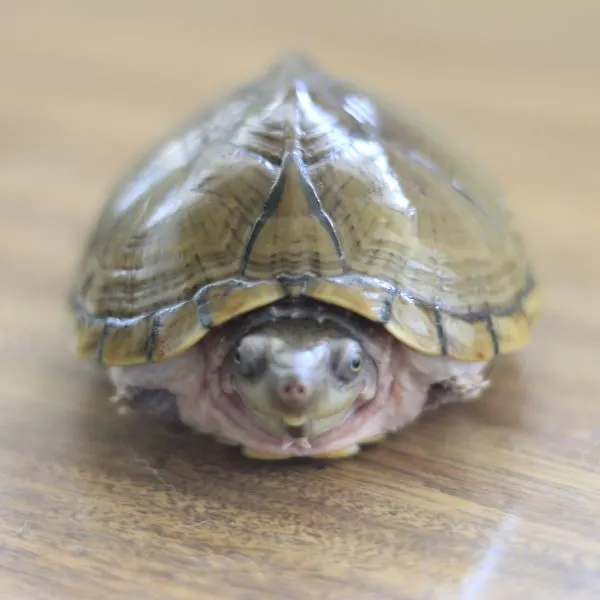
Musk turtles (Sternotherus)- Musk turtles spend most of their time in water. They hardly bask or leave the water. While musk turtles vary in size, they are small turtles.
Even the largest musk turtle, the razorback, has a carapace length of 6.3 inches.
Common musk turtle species include the common musk turtle, razorback musk turtle, and the flattened musk turtle. Expect to pay $20 to $60.

Mud turtles (Kinosternon)- Mud turtles are very similar to musk turtles. Not only do both turtles have similar dietary requirements, but also they have similar enclosure requirements.
Common mud turtle species include the eastern mud turtle, yellow mud turtle, and scorpion mud turtle. These North American turtles are easy to care for and are quite lively pets. Expect to pay $10 to $50.

Snappers- Snapping turtles are large and require an outdoor pond to be comfortable. Alligator snapping turtles (Macrochelys temminckii) can reach lengths of 31 inches, while common snapping turtles (Chelydra serpentina) can reach lengths of 20 inches. Expect to pay $15 to $50.

Sliders (Trachemys scripta)- Popular sliders like red-eared slider turtles (T. s. elegans), Cumberland sliders and yellow-bellied sliders are all considered Pond Sliders which are also known as Sliders. They are generally colorful and lively turtles. Expect to pay $10 to $50.

Cooters (Pseudemys)- Cooters are known to be friendly, especially towards other turtles. As such they make excellent community turtles. Cooters are large turtles, with some species reaching lengths of 20 inches. Common species include the River cooter, red-bellied cooter, and the Peninsula cooter. Expect to pay $20 to $130.
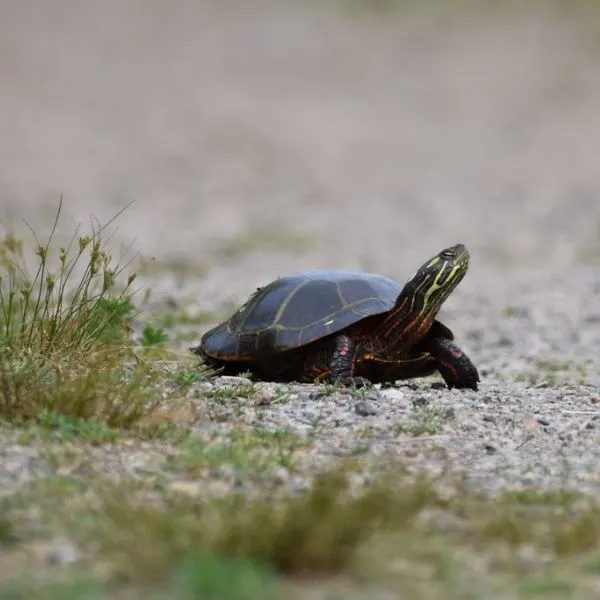
Painted Turtles (Chrysemys) – Painted turtle species are some of the most common types of aquatic pet turtles out there. They are spread all over the Midwest and the rest of the United States.
There are four subspecies of painted turtles including the Eastern Painted turtle, Western Painted turtle, Southern Painted turtle, and Midland Painted turtle. Expect to pay $30 to $50.

Spotted Turtles (Clemmys) – Spotted turtles make for a great pet because they are small turtles and only grow to be a maximum of 5 inches. They are still a semi-aquatic species but their tank won’t need to be as large as say a female yellow-bellied turtle.
Expect to pay $175 to $700.
The Turtle’s Enclosure
Since turtles are semi-aquatic, they require an aquarium or a pond. However, they generally require more space depending on their size. The aquarium size that a turtle requires is down to the size.
Small 4-inch turtles can thrive in a 25-gallon tank. However large turtles, with carapace lengths of 10 inches, need a 75-gallon tank. You can also keep turtles outdoors.
Turtles native to North America thrive in outdoor enclosures if you live in a temperate region.
However, if you don’t want your turtle to hibernate (and you don’t want that), they need to be housed indoors during the autumn and winter.
Aquarium

The cost of an aquarium generally depends on the tank size. A 25-gallon tank costs about $100, while a 40-gallon tank costs about $280. Most pet turtles will do just fine in a 40-gallon tank. Large turtles may require a 120-gallon tank. I recommend the Tetra Glass Aquarium and the SeaClear Aquarium.
Outdoor Enclosure
If you plan on keeping a turtle outdoors, then you need a pond. Having a pond installed can be quite expensive. A pond can cost between $1000 to $3000. Box turtles are terrestrial and do not require a pond. As with tortoises, a box turtle’s enclosure costs between $100 and $200 to set up.
Substrate

A turtle’s enclosure doesn’t require substrates. Substrates can even make the tank harder to clean. If however, you must have substrate, I recommend river pebbles. This should cost you about $25. I recommend the Exo Terra Turtle Pebbles.
Filter

To ensure the aquarium water is always clean, you must install a filter. It is best to install a filter marked for at least double the size of the enclosure. A filter costs about $70 to $200. I recommend the SunSun HW-302.
Water Conditioner
The chlorine in tap water makes it unsuitable for turtles. To neutralize the chlorine or chloramines in the water used for the aquarium, you must add a water conditioner like this one from Zoo Med. This costs about $10.
Turtle Ramp

In order to bask, the turtle must get out of the water first. A turtle ramp or basking platform provides the turtle with a place to bask and dry off. A turtle ramp costs about $30. You can also build a homemade platform if you have large specimens. Both the Penn Plax Turtle Tank Topper and this hanging platform are excellent choices.
Basking Lamp

Since turtles are cold-blooded, they regulate their body temperature by basking. A good basking lamp is a must.
- The lamp itself should cost about $30.
- The lamp fixture to hold the lamp costs about $25.
I recommend the Zoo Med Repticare Ceramic Heat Emitters and the REPTI ZOO Lamp Fixture. As with a tortoise’s enclosure, ceramic lights are best.
Aquarium Heater
If the water temperature is lower than the turtle can tolerate, you need to increase the temperature by installing a submersible heater. I recommend the Aqueon Pro Heater. A water heater should cost you about $40.
UVB Lamp & Reflector

In addition to heating, the turtle needs a UVB lamp. The best UVB lamps are the ReptiSun 10.0 and the ReptiSun 5.0.
- A UVB lamp costs about $15.
- A UVB lamp reflector costs about $30.
Thermostat

With turtles, you need a thermostat for the heat lamp and a separate thermostat for the water heater. Some thermostats can regulate several heating devices at the same time. However such thermostats are quite expensive
A dimming thermostat should cost about $50 at your local pet shop. I recommend the INKBIRD ITC-308 (read the review here).
Turtle Food Cost
As primarily carnivorous animals, a large portion of their diet should be made up of animal protein such as crickets (create a cricket farm), earthworms, feeder fish, chicken, and tilapia.
Acquiring the needed foods can be complicated. Rather, I recommend that beginners feed their turtles packaged commercial turtle diets. A pack will cost you under $20 and can last you the entire month. Additionally, they are supplemented with major nutrients such as calcium and vitamin D.
In addition to the commercial diets, they also accept greens such as pondweed, and duckweed. Endive, escarole, kale, anacharis, and many others.
A single turtle’s monthly feeding cost should be around $30 or even less.
You can learn more here about what turtles eat.
Herp Vet Fees
(Refer to the same section under tortoises.)
Turtle Insurance (Optional)
As a turtle owner, you’re invested in the health and well-being of your shelled companion. While you’ve planned for the recurring expenses of food, habitat maintenance, and annual vet visits, there’s one more aspect of financial planning to consider: turtle insurance.
The Role of Insurance in Turtle Care Turtle insurance is a niche but valuable service that provides coverage for veterinary expenses. Given that turtles can live for several decades, the probability of incurring medical costs increases with age. Insurance can help alleviate the burden of these unforeseen expenses.
Coverage Details A typical turtle insurance plan might include:
- Routine check-ups and preventative care
- Emergency treatments and surgeries
- Prescribed medications
- X-rays and other diagnostic tests
- Treatment for hereditary conditions or diseases
Premiums for turtle insurance can vary, with basic plans potentially starting at around $5 to $10 per month. However, premiums can rise based on the coverage scope, the age of the turtle, and the deductible chosen.
Assessing the Need for Insurance Before deciding on turtle insurance, evaluate the potential costs of veterinary treatments against the insurance premiums over the course of your turtle’s life. If the peace of mind that comes with having health coverage for your pet is important to you, insurance might be a worthwhile investment.
How to Choose the Best Policy When comparing policies, it’s crucial to consider:
- The annual coverage limit and whether it aligns with potential vet costs
- The deductible amount and how it affects your monthly premiums
- Exclusions that might impact the relevance of the policy to your turtle’s needs
- The insurance provider’s reputation and reviews from other pet owners
Incorporating Insurance into Your Budget If you decide that turtle insurance is the right choice, consider it as part of your long-term financial planning for pet care. Add the estimated insurance cost to the monthly care budget we’ve outlined to ensure you have a comprehensive view of the ongoing costs associated with turtle ownership.
Initial Average Cost Of A Turtle
| The Turtle | Cost |
|---|---|
| The turtle | ~$30 |
| Enclosure | ~$280 |
| Bedding(optional) | ~$25 |
| UVB lamp & reflector | ~$45 |
| Thermostat | ~$50 |
| Filter | ~$100 |
| Water conditioner | ~$10 |
| Turtle ramp/Basking platform | ~$30 |
| Aquarium heater | ~$40 |
| Ceramic heat lamp & lamp fixture | ~$55 |
| Food (for the first month) | ~$30 |
| First veterinarian check-up | ~$55 |
| Total | ~$750 |
Long-Term Care Costs for Turtle Owners
Owning a turtle involves a significant time and financial commitment. Beyond the initial setup for housing and the first veterinary visit, there are ongoing costs that every turtle owner should anticipate. These costs ensure that your turtle remains healthy and content throughout its potentially long life, which can span several decades.
Feeding Costs: The most consistent long-term cost will be feeding your turtle. Depending on the species, diets can range from leafy greens and vegetables to live prey like worms and feeder fish. On average, expect to spend around $20 to $40 per month on food. Remember, while juvenile turtles eat daily, adult turtles may eat every second day, which can reduce food costs as they grow.
Supplements: Turtles require calcium and vitamin supplements, especially if they are not receiving enough sunlight for natural vitamin D synthesis. A container of calcium or vitamin powder can cost between $5 to $15 and may last several months depending on usage.
Utility Costs: UVB and heating lamps consume electricity and will add to your utility bills. While the cost varies by region, anticipate an increase in your electric bill by approximately $5 to $15 per month to maintain the proper temperature and lighting conditions.
Replacement of Equipment: Equipment such as UVB bulbs, heat lamps, filters, and water heaters will need replacement periodically. Bulbs typically need replacement every six months and can cost between $15 to $30 each. Filters and heaters can last several years but expect replacement costs to range from $20 to $200 when the time comes.
Veterinary Care: Regular check-ups with a herp vet are important to prevent and treat health issues. An annual check-up can range from $50 to $100, not including any additional treatments or tests. Setting aside a contingency fund for unexpected health issues is also a wise decision for any pet owner.
Additional Substrate and Cleaning Supplies: Substrates like coconut fiber and peat moss will need to be replaced regularly to maintain a clean and healthy habitat. This could add up to $10 to $30 every few months. Additionally, cleaning supplies and water conditioners will contribute to minor ongoing costs.
Miscellaneous Expenses: Consider the potential for other miscellaneous expenses, such as tank upgrades as your turtle grows or replacements for damaged items. While these costs are not monthly, they can add up, especially if your turtle outgrows its space or if you decide to enhance the habitat with new features.
In summary, while turtles are often perceived as low-maintenance pets, the reality is that their long-term care requires both financial planning and dedication. Potential turtle owners should budget for these ongoing costs to ensure they can provide a nurturing environment for their shelled companions over the long haul.
Below is a table that breaks that down:
| Item | Description | Cost (USD) | Frequency |
|---|---|---|---|
| Food | Balanced diet of greens, pellets, and protein | $20 – $40 | Monthly |
| Supplements | Calcium and vitamin D supplements | $5 – $15 | Every few months |
| Utility Costs | Electricity for UVB and heating lamps | $5 – $15 | Monthly |
| Equipment Replacement | UVB bulbs, heat lamps, filters, water heaters | $15 – $200 | As needed |
| Veterinary Care | Annual check-ups and unexpected health issues | $50 – $100 (check-ups) | Annually + as needed |
| Substrate | Coconut fiber, peat moss, etc. | $10 – $30 | Every 3-4 months |
| Cleaning Supplies | Tank cleaning agents, water conditioners | Varies | As needed |
| Miscellaneous | Tank upgrades, habitat enhancements | Varies | As needed |
| Total | $40 – $80 | Monthly |
Where to buy a turtle or a tortoise
There are numerous turtle breeders selling live turtles and tortoises online. You can also buy them at your local pet store generally speaking. You will have the option to buy an adult turtle, but one thing you should look out for is that it is not a wild turtle.
All of the recommended breeders on our for-sale pages are captive breeders, so you never need to worry about someone selling wild-caught turtles.
See our following pages for more:
The Benefits of Turtle Adoption
In addition to purchasing a turtle from a breeder or pet store, adopting a turtle is a responsible and compassionate option to consider. Adoption not only gives a second chance to turtles in need of a home but can also be more cost-effective. Here’s what you should know about the adoption process:
Why Adopt a Turtle? Many turtles are in need of homes for various reasons, such as owners who can no longer care for them or rescue them from unfavorable conditions. By adopting, you’re providing a loving home to a turtle that might otherwise go without.
Cost Advantages Adoption fees are generally lower than the cost of buying a turtle from a breeder or pet store. Additionally, adopted turtles often come with their enclosures and other necessary supplies, which can save on initial setup costs. On average, adoption fees can range from a small donation to around $50 to $100, depending on the rescue organization.
Health and Temperament Rescue organizations often provide veterinary care before adoption, which means the turtle will likely be up-to-date on health checks and treatments. Also, the staff can provide insights into the turtle’s behavior and temperament, ensuring a good fit for your home.
Supporting Turtle Welfare By adopting, you support the welfare work of rescue organizations and reduce the demand for wild-caught or poorly bred turtles. It’s a step towards more ethical pet ownership and the conservation of turtle species.
How to Adopt To adopt a turtle, you can start by checking with local animal shelters, reptile rescue organizations, or online rescue networks. Be prepared to fill out an application and possibly go through a home inspection to ensure you can provide a suitable environment.
Post-Adoption Support Many organizations offer post-adoption support, which can be invaluable for first-time turtle owners. They can provide care sheets, dietary advice, and even assistance if challenges arise in the future.
Sea Turtles

Sea turtles cannot legally be pets and should not be pets. These are all endangered species and if you come across them nesting on a beach, or their eggs hatching you should not pick them up.
Conclusion
There are several factors to consider when adopting a turtle. Some of these factors include time commitment and expenses. Initial expenses can be as low as $450 or as high as $1500.
Expenses include the cost of the turtle, the cost of setting up the enclosure, the cost of food, and many more. Of course, initial expenses are usually the highest. Continuing expenses are much lower.
Land turtles tend to be easier to set up when compared to aquatic turtles, but they will require a bit more space for them to be able to comfortably roam around.
However, unplanned occurrences such as injury or illness can be problematic. You must factor in the unknown. I hope that this article gives you a ballpark number to work with.
If you have any questions or additional information, I encourage you to leave them in the comment section below.




